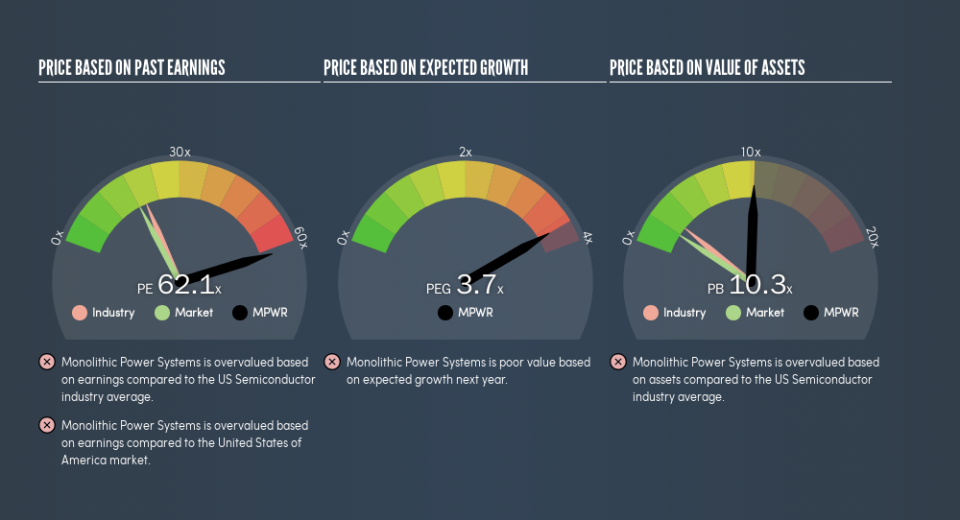Despite Its High P/E Ratio, Is Monolithic Power Systems, Inc. (NASDAQ:MPWR) Still Undervalued?

This article is written for those who want to get better at using price to earnings ratios (P/E ratios). We'll look at Monolithic Power Systems, Inc.'s (NASDAQ:MPWR) P/E ratio and reflect on what it tells us about the company's share price. What is Monolithic Power Systems's P/E ratio? Well, based on the last twelve months it is 62.13. In other words, at today's prices, investors are paying $62.13 for every $1 in prior year profit.
See our latest analysis for Monolithic Power Systems
How Do I Calculate A Price To Earnings Ratio?
The formula for P/E is:
Price to Earnings Ratio = Share Price ÷ Earnings per Share (EPS)
Or for Monolithic Power Systems:
P/E of 62.13 = $154.8 ÷ $2.49 (Based on the trailing twelve months to December 2018.)
Is A High Price-to-Earnings Ratio Good?
A higher P/E ratio means that investors are paying a higher price for each $1 of company earnings. That isn't a good or a bad thing on its own, but a high P/E means that buyers have a higher opinion of the business's prospects, relative to stocks with a lower P/E.
How Growth Rates Impact P/E Ratios
Earnings growth rates have a big influence on P/E ratios. If earnings are growing quickly, then the 'E' in the equation will increase faster than it would otherwise. Therefore, even if you pay a high multiple of earnings now, that multiple will become lower in the future. So while a stock may look expensive based on past earnings, it could be cheap based on future earnings.
In the last year, Monolithic Power Systems grew EPS like Taylor Swift grew her fan base back in 2010; the 58% gain was both fast and well deserved. The sweetener is that the annual five year growth rate of 32% is also impressive. So I'd be surprised if the P/E ratio was not above average.
Does Monolithic Power Systems Have A Relatively High Or Low P/E For Its Industry?
The P/E ratio essentially measures market expectations of a company. You can see in the image below that the average P/E (20.4) for companies in the semiconductor industry is a lot lower than Monolithic Power Systems's P/E.
That means that the market expects Monolithic Power Systems will outperform other companies in its industry. The market is optimistic about the future, but that doesn't guarantee future growth. So further research is always essential. I often monitor director buying and selling.
Remember: P/E Ratios Don't Consider The Balance Sheet
Don't forget that the P/E ratio considers market capitalization. That means it doesn't take debt or cash into account. Hypothetically, a company could reduce its future P/E ratio by spending its cash (or taking on debt) to achieve higher earnings.
Spending on growth might be good or bad a few years later, but the point is that the P/E ratio does not account for the option (or lack thereof).
How Does Monolithic Power Systems's Debt Impact Its P/E Ratio?
The extra options and safety that comes with Monolithic Power Systems's US$377m net cash position means that it deserves a higher P/E than it would if it had a lot of net debt.
The Bottom Line On Monolithic Power Systems's P/E Ratio
Monolithic Power Systems's P/E is 62.1 which suggests the market is more focussed on the future opportunity rather than the current level of earnings. Its net cash position is the cherry on top of its superb EPS growth. To us, this is the sort of company that we would expect to carry an above average price tag (relative to earnings).
Investors have an opportunity when market expectations about a stock are wrong. If the reality for a company is better than it expects, you can make money by buying and holding for the long term. So this free visualization of the analyst consensus on future earnings could help you make the right decision about whether to buy, sell, or hold.
You might be able to find a better buy than Monolithic Power Systems. If you want a selection of possible winners, check out this free list of interesting companies that trade on a P/E below 20 (but have proven they can grow earnings).
We aim to bring you long-term focused research analysis driven by fundamental data. Note that our analysis may not factor in the latest price-sensitive company announcements or qualitative material.
If you spot an error that warrants correction, please contact the editor at editorial-team@simplywallst.com. This article by Simply Wall St is general in nature. It does not constitute a recommendation to buy or sell any stock, and does not take account of your objectives, or your financial situation. Simply Wall St has no position in the stocks mentioned. Thank you for reading.

 Yahoo Finance
Yahoo Finance 
